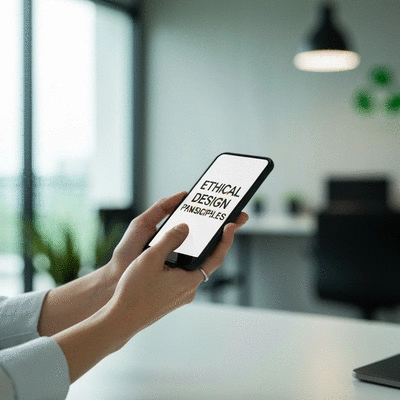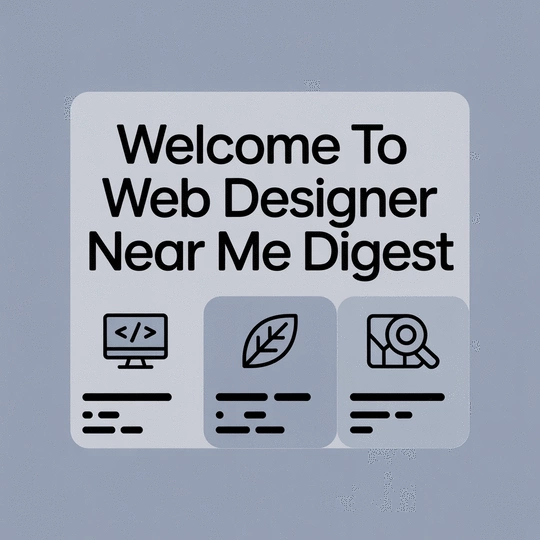The future of web design is not just about aesthetics; it’s about creating a harmonious relationship between technology and our environment. With sustainable web design, every decision made can contribute to a healthier planet while enhancing user experience. This article reveals how these practices can transform your approach to web design.
What You Will Learn
- Sustainable web design minimizes energy consumption and reduces waste, benefiting both users and the environment.
- Implementing energy-efficient hosting and optimized images can significantly lower your website's carbon footprint.
- A focus on sustainability often leads to improved load times, better navigation, and enhanced user satisfaction.
- Ethical design practices, such as prioritizing user privacy and transparency, reinforce trust and engagement with users.
The Pillars of Sustainable Web Design & UX Enhancement
This visual outlines the core components of sustainable web design and how they intrinsically improve user experience, fostering a greener digital landscape. Embracing sustainable web design principles is key to achieving these benefits.
Sustainable Design Core Principles
- • Energy-efficient coding
- • Green hosting solutions
- • Minimalist design principles
Enhanced User Experience Factors
- • Improved load times
- • Easier navigation
- • Increased user trust & loyalty
The Connection Between Sustainable Web Design and User Experience
As the founder of Web Designer Near Me Digest, I've seen firsthand how the principles of sustainable web design not only benefit the environment but also improve user experience. Sustainable web design refers to creating websites that are environmentally responsible and resource-efficient throughout their lifecycle. This means considering the environmental impact of every decision made during the design and development process, from the code to the hosting solutions.
In today's digital age, where users are increasingly aware of their ecological footprint, implementing sustainable design practices is not just a trend—it's becoming essential. By prioritizing sustainability, we can create websites that not only look great but also serve a greater purpose, promoting a healthier planet.

Understanding Sustainable Web Design
Sustainable web design emphasizes long-term environmental responsibility. It involves designing websites that minimize energy consumption, reduce waste, and promote efficiency. Sustainability is about making mindful choices that align with environmental values while also meeting user needs. For instance, using energy-efficient hosting and optimizing images can significantly reduce a website's carbon footprint. For more insights, consider exploring sustainable web design and carbon impact.
- Focus on energy-efficient coding practices.
- Prioritize green hosting solutions.
- Utilize sustainable design frameworks.
By incorporating these elements, we can create websites that are not only functional but also contribute positively to the environment. This shift towards sustainability reflects a growing movement in web development that seeks to balance user needs with ecological responsibilities.
Enhancing User Experience Through Sustainability
When we think about user experience, sustainability plays a crucial role in enhancing satisfaction and overall engagement. A sustainably designed website often translates to faster load times, easier navigation, and a more enjoyable browsing experience. As a user, how frustrating is it to click on a slow-loading page? By focusing on sustainability, we inherently improve the performance of our websites, making them more user-friendly.
- Improved load times lead to lower bounce rates.
- Efficient design promotes ease of navigation.
- Sustainable practices build user trust and loyalty.
In my experience, users appreciate knowing that their online activities are contributing to a healthier planet. This connection fosters a deeper relationship between the user and the website, ultimately leading to a more satisfying experience.
Pro Tip
To further enhance user experience while implementing sustainable web design, consider conducting regular performance audits of your website. This will help identify areas for improvement, ensuring your site remains efficient and eco-friendly. Tools like Google PageSpeed Insights or GTmetrix can provide valuable insights into load times and user engagement metrics.
Summarizing the Benefits of Sustainable Web Design
As we wrap up our discussion, it's clear that sustainable web design plays a vital role in enhancing user experience while supporting broader environmental goals. By prioritizing sustainability, we not only create websites that function effectively but also contribute positively to the planet. Imagine a world where every click helps reduce our carbon footprint—this is the future we can work towards together!
Implementing sustainable practices can improve user engagement, boost satisfaction, and build a sense of trust between a business and its audience. Websites designed with sustainability in mind are often more efficient and user-friendly, leading to happier visitors and better retention rates. Let’s dive deeper into how we can harness these benefits!

Call to Action for Implementing Sustainable Design
Now is the perfect time to assess your own website and consider making sustainable changes! Here are a few actionable steps you can take:
- Evaluate your current design for energy efficiency—are there unnecessary elements slowing your site down?
- Consider switching to a green hosting provider that prioritizes renewable energy sources.
- Implement minimalist design principles to enhance user navigation and reduce cognitive load.
- Ensure your site is accessible to all users, which is a key aspect of sustainable design.
Each small change can contribute to a larger impact, making your website not just a platform for business, but a force for good. By engaging in sustainable design practices, you’ll not only elevate your brand but also inspire others in your community to follow suit!
Future Trends in Sustainable Web Design
The field of sustainable web design is constantly evolving, and I’m excited about the future! Some emerging trends to watch out for include:
- AI in Design: Leveraging artificial intelligence to optimize user experience while maintaining sustainability.
- Modular Design: Creating flexible and reusable design components that minimize waste and enhance efficiency.
- Personalization through Sustainability: Tailoring user experiences based on sustainable practices that resonate with audience values.
These trends are not just buzzwords; they represent a shift towards a more responsible and thoughtful approach to web design. As we embrace these changes, we can create a more sustainable digital landscape that benefits everyone.
Integrating Ethical Design Practices for a Greener Future
Finally, it’s essential to recognize the importance of ethical design in achieving both sustainability and social responsibility. By incorporating ethical practices into your design process, you can make a powerful statement about your brand’s values. Consider these practices:
- Prioritizing user privacy and data security in your designs.
- Ensuring transparency in your business practices, especially regarding sustainability claims.
- Engaging with your audience to understand their needs and preferences better.
As we move forward, let's stay committed to integrating ethical considerations into our design processes. Together, we can create a future that not only prioritizes user experience but also fosters trust and responsibility in our digital interactions. Remember, every small step counts in building a greener, more sustainable future for all of us!
Frequently Asked Questions About Sustainable Web Design
What is sustainable web design?
Sustainable web design is the practice of creating websites that are environmentally responsible and resource-efficient throughout their entire lifecycle, from design and development to hosting and user interaction. It aims to minimize energy consumption and reduce the carbon footprint of digital products.
How does sustainable web design improve user experience?
Sustainable web design often leads to improved load times due to optimized code and images, easier navigation through minimalist design principles, and increased user trust and loyalty because users appreciate environmentally conscious practices. These factors collectively enhance the overall user experience.
What are some key principles of sustainable web design?
Key principles include focusing on energy-efficient coding practices, prioritizing green hosting solutions (powered by renewable energy), utilizing minimalist design principles to reduce data transfer, and optimizing images and media for faster loading.
Why is green hosting important for sustainable web design?
Green hosting providers power their servers with renewable energy sources, significantly reducing the carbon emissions associated with keeping websites online. Choosing such a provider is a crucial step in lowering a website's environmental impact.
What are ethical design practices in the context of sustainable web design?
Ethical design practices involve prioritizing user privacy and data security, ensuring transparency in business and design processes, and engaging with users to better understand their needs and preferences. These practices build trust and reinforce a brand's values, contributing to a more responsible digital ecosystem.
Recap of Key Points
Here is a quick recap of the important points discussed in the article:
- Sustainable web design balances environmental responsibility with user needs.
- Implement energy-efficient coding and prioritize green hosting solutions.
- Sustainability enhances user experience through improved load times and navigation.
- Adopting minimalist design principles can reduce cognitive load and improve efficiency.
- Ethical design practices foster trust and transparency with users.
- Future trends include AI in design and modular components for greater efficiency.







